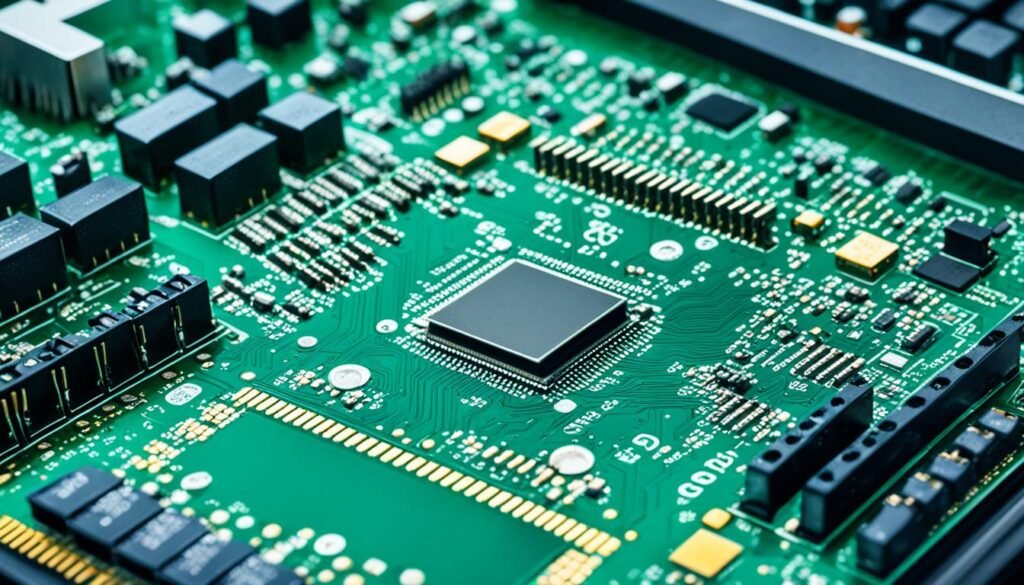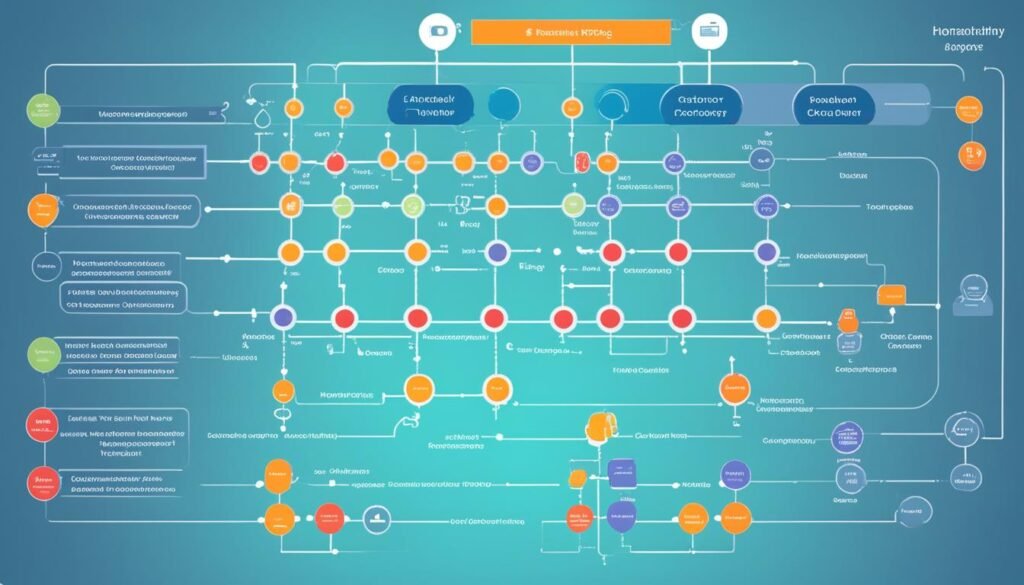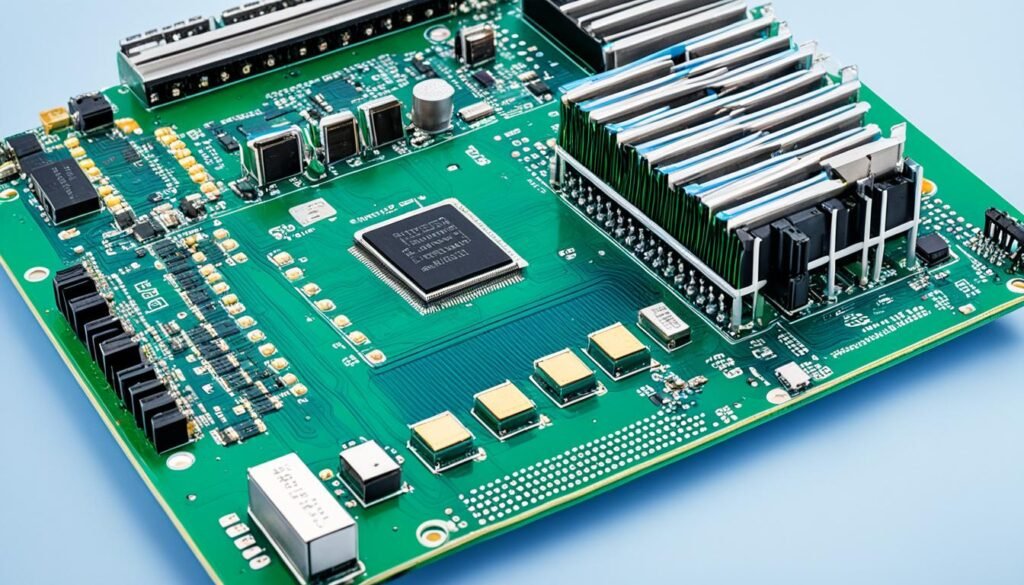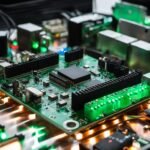Real-time operating systems (RTOS) are key for smooth running of critical applications. They are vital in fields like aerospace, defense, and medical devices. RTOS make sure important tasks are done on time1. These systems have grown a lot since the 1960s at the University of Cambridge. They promise reliability and fast action in places needing quick decisions1.
RTOS focus on speed and accuracy, unlike general-use OSes that care more about multitasking and ease of use1. They can switch tasks super fast, in about three microseconds1. This makes them perfect for systems where time is everything and tasks must be done quickly1.
Over time, real-time systems have gotten better at managing memory and working correctly. They are complex but bring big benefits in some areas, like needing special algorithms and fast device drivers1.
Key Takeaways
- Real-time operating systems are key for timely and reliable actions in many fields1.
- They have improved a lot, making task scheduling better and handling more complex tasks12.
- These systems focus on fast performance, putting critical tasks first. This cuts down on system delays and boosts speed12.
- RTOS use a special scheduling method based on task priority. This is crucial in situations needing strict timing2.
- Learning about RTOS helps us use technology better in precise industries like medical and aerospace2.
- With 5G, RTOS are more important for fast, low-latency communication and quick responses2.
- Even with challenges like needing special skills, RTOS bring big benefits in making real-time systems more predictable and efficient12.
Understanding Real Time Operating Systems
Real time operating systems (RTOS) are key to modern embedded systems. They manage hardware and time-sensitive tasks well.
Definition and Importance
RTOS are made for tasks that need to be done on time and reliably. They are vital in safety-critical areas like medical devices and car control systems. Here, tasks must be done quickly to avoid accidents3.
RTOS make sure tasks meet deadlines, preventing system failures3.
History and Evolution of RTOS
RTOS have changed a lot over time. They’ve moved from simple time-sharing to complex systems that handle many tasks quickly. These systems use advanced scheduling and synchronization methods3.
Real-time computing means reacting fast, which is key in avoiding big problems4.
Key Characteristics of RTOS
RTOS make the most of resources, improving system performance and efficiency. They sort tasks by importance and timing3. This means tasks are done consistently, with little delay.
Tools like mutexes and semaphores help tasks work together without errors3. Systems are classified as hard, firm, or soft RTOS based on their timing needs. Hard RTOS, like in aircraft controls, must meet strict deadlines to prevent disasters3.

The Architecture of RTOS
In the world of real time computing, the architecture of real time operating systems (RTOS) is key. It helps achieve high efficiency and reliability in embedded systems and other real time environments. Understanding how an RTOS is laid out and what it does is crucial for those in this field.
Components and Structure
An RTOS is made to handle tasks quickly, usually in milliseconds5. It has key parts like task schedulers, interrupt handlers, and ways for tasks to talk to each other. Memory management is also critical, designed for fast responses and the strict limits of embedded systems5.
These systems are found in many technologies and are vital in cars, like engine control units and systems that help drivers, which need tasks done on time for safety6.
Kernel Responsibilities in RTOS
The kernel in an RTOS acts like a conductor, making sure everything works together well. It doesn’t do tasks itself but makes sure they get done based on priority. It handles interrupts and gives out system resources well. This way, the system works as expected, which is crucial in critical uses like airplane sensors and medical devices5.
RTOS designs vary from monolithic to microkernel architectures, each with its own benefits and challenges. Monolithic RTOS manage everything in the kernel, leading to great performance but making updates hard. Microkernel systems have a simple kernel that manages basic services, making the system more reliable and secure by keeping errors separate7.
RTOS designs also differ in how they handle updates and maintenance. Microkernel systems can restart services without a full reboot, which is good for keeping systems running and easy maintenance. Monolithic systems often need a full reboot, which means more downtime and harder updates7.

Real Time Operating Systems, RTOS Concepts, RTOS in Embedded Systems, OS Concept
Learning about real-time operating systems (RTOS) is key to making embedded software development better. An RTOS works closely with the hardware to make sure tasks are done on time in embedded systems.

An RTOS is great at managing tasks and making sure they’re done when they need to be. This is vital for systems that can’t wait, like in medical devices or aerospace controls89. It helps avoid failures that could be deadly or cause big problems.
| RTOS Category | Response Requirement | Examples |
|---|---|---|
| Hard RTOS | Strict time constraints | Vehicle airbag systems, Pacemakers |
| Firm RTOS | Constrained but adaptable | Streaming services |
| Soft RTOS | Flexible, as soon as possible | Office document editing tools |
RTOSs are different from other operating systems because they focus on quick responses and exact timing. This OS concept lets developers set tasks to run in real-time, making sure everything works perfectly9.
Using more processors in RTOS concepts can help with heavy loads and make systems faster9. The secret to these systems is not just quick responses but also keeping up well under various loads and conditions.
Understanding RTOS concepts helps developers make systems that are not just efficient but also strong and dependable. It gets them ready for the challenges of embedded software development, ensuring the system works its best and reliably.
Types of Real-Time Operating Systems
Real-time systems come in many types, each suited for different needs. Knowing about RTOS types helps improve your system’s performance and reliability.
Hard RTOS Characteristics
Hard real-time operating systems are for tasks that must be done on time, every time. They’re used in critical areas like aerospace and medicine, where missing a deadline can be disastrous. These systems are known for their reliability, making them perfect for safety-critical tasks1011.
Soft RTOS and Its Use-Cases
Soft RTOS systems can handle small delays without major issues. They’re great for tasks where a delay won’t cause a big problem. You’ll find them in digital audio and streaming, where a little wait is okay. These systems focus on getting things done quickly and are popular in consumer electronics12.
Firm Real-Time Operating Systems Explained
Firm RTOS systems are a mix of hard and soft systems. They keep to time limits but allow some flexibility before things start to go wrong. They’re perfect for multimedia tasks where losing a frame isn’t the end of the world but quality matters. Firm RTOS systems balance quality and flexibility, making them great for video conferencing and multimedia12.

| RTOS Type | Time Sensitivity | Common Applications |
|---|---|---|
| Hard RTOS | Strict | Aerospace, Medical Systems10 |
| Soft RTOS | Moderate | Digital Audio, Consumer Electronics12 |
| Firm RTOS | Semi-strict | Video Conferencing, Multimedia12 |
Understanding these RTOS types helps organizations pick the right system for their needs. Each type is designed for different levels of urgency, affecting how deadlines are met12.
RTOS in Embedded Systems
In the world of embedded systems, real-time performance is a must. An RTOS, or real-time operating system, is key to meeting these high demands from start to finish.
Integration with Hardware
RTOS in embedded systems is known for its quick and predictable responses to events11. This is vital in areas like automotive systems, where timing is everything. Using an RTOS makes hardware integration smoother, helping developers make the most of system resources11.
Benefits for Embedded Applications
An embedded os is all about handling urgent tasks fast. RTOS helps with this through priority scheduling, making code cleaner and easier to maintain11. It also makes the system more modular and easier to test, which is crucial for error-free development11.
RTOS improves task management and reduces errors, making systems more reliable and efficient. This is true for everything from cars to medical devices, making them better with an RTOS.
RTOS changes how embedded systems are designed and developed. It makes sure urgent tasks get done fast and efficiently13. The way RTOS schedules tasks lets systems handle more tasks better and faster1113.
When picking an RTOS, think about licensing, the company behind it, and the support it offers11. Trust and quality are key to a system’s stability and how well it works.
Adding RTOS to embedded systems makes development easier and protects against problems. This ensures the system does more than just meet performance goals; it beats them.
Core RTOS Concepts: Multitasking and Scheduling
Real-time operating systems (RTOS) are great for tasks that need multitasking and precise scheduling. They make sure important tasks are done on time. This is key in areas like aerospace and medicine, where timing is everything.
Priority-based preemptive scheduling is a big deal in real-time systems. It sorts tasks by priority, so urgent ones get done first. This makes systems work better and faster14. It also makes them more reliable and predictable15.
Priority-Based Preemptive Scheduling
This scheduling method is crucial for safe systems. In fields like industrial automation or medical monitoring, it’s vital. It makes sure critical tasks are done right away, keeping things running smoothly1410.
Rate Monotonic and Round-Robin Techniques
Rate monotonic scheduling gives tasks a priority based on how often they need to run. The more often a task runs, the higher its priority. This is good for systems where tasks have a clear order, making things simpler15. Round-robin scheduling shares time equally among tasks. This stops one task from taking too much time, keeping things fair and preventing bottlenecks.
RTOS systems are great at handling many tasks at once. They make the most of their power, giving each task the attention it needs1510.
Learning about these RTOS concepts shows how important they are. They help make systems that are reliable, efficient, and meet the high demands of today’s tech.
Operating System Fundamentals for RTOS Design
In the world of embedded development, RTOS in embedded systems is key. It’s crucial for apps where timing is a must. Mastering operating system fundamentals is vital. This means understanding how to manage tasks and set priorities in real time systems.
At the heart of RTOS design, managing and prioritizing tasks is key. Systems must make sure high-priority tasks get done first. This is done through preemptive scheduling, which is vital in apps like flight control or medical devices16. An RTOS’s ability to multitask lets many operations run at once, making apps more efficient16.
How an RTOS uses resources is also crucial. With many tasks running together, it must handle CPU and memory well to avoid problems16. Choosing the right RTOS means looking at the project’s needs and the device’s specs16. For example, the nRF52832 SoC and BGM113 BLE module work well with some RTOS solutions16.
Knowing these basics helps developers make systems that grow and adapt. Whether for small devices or big systems, RTOS design is key to better performance and reliability.
| Feature | Importance in RTOS | Example |
|---|---|---|
| Task Prioritization | Ensures critical operations are handled first | Medical devices, Flight control systems |
| Multitasking | Increases system throughput and efficiency | Concurrent sensor data processing in IoT devices |
| Resource Management | Prevents system overload and ensures stability | Memory management in consumer electronics |
By using these operating system basics, developers can overcome RTOS design challenges. This makes their systems reliable and ready for tough demands. This approach boosts system reliability and opens up new uses for RTOS in tech fields16.
Synchronization in RTOS: Mutexes and Semaphores
Real time operating systems rely on tools like mutexes and semaphores to run smoothly. These tools help manage shared resources, avoiding problems like priority inversion and resource conflicts.
Understanding Mutex
A mutex, or mutual exclusion object, lets only one thread access a resource at a time. This ensures data integrity by preventing conflicts. Mutexes are key in multithreading, providing locks to protect critical sections17. They also help solve priority inversion issues, like the NASA Mars Pathfinder rover incident18.
Implementing Semaphores
Semaphores, binary or counting, are vital for managing processes in real time systems. Binary semaphores control access to one shared resource and start at 117. Counting semaphores manage multiple resources, with a value that can vary widely17. They tackle issues like deadlocks and resource starvation, which happen when processes block each other17.
Overcoming Priority Inversion
Priority inversion is a big challenge in RTOS, where a lower priority task blocks a higher one. Priority inheritance helps by giving the lower task the higher priority temporarily to break the deadlock1819. Tools like Percepio Tracealyzer show how tasks and synchronization work together, helping with debugging and improving RTOS systems19.
Using mutexes and semaphores correctly in a RTOS is key to avoiding problems like deadlocks and priority inversion. These tools are vital for meeting the high demands of timing and efficiency in critical environments.
Threads and Multicore Processing in RTOS
Real time operating systems (RTOS) need to know how threading and multicore processing work. These are key for making RTOS better and more efficient. They are very important for systems that need to work fast and use resources well.
Thread Management for Concurrency
Threads in an RTOS let different parts of a process work at the same time. Good thread management makes sure things run smoothly together. It also makes the system faster and more responsive.
This is very important for embedded systems. They use these features to stay stable and meet deadlines. This helps use resources well and makes the system reliable3.
Using things like preemptive scheduling and setting task priorities helps. This makes sure important tasks get the resources they need on time. This is very important in places like hospitals or cars, where things have to work perfectly3.
Optimizing for Multicore Systems
Multicore processing has changed how RTOS work. It makes embedded systems work faster and better. By spreading tasks across multiple cores, RTOS can reduce delays and do more work at once.
This way of managing tasks is important for keeping RTOS applications running well. It makes sure tasks are given to the right core based on their needs3.
Multicore processing is now common in RTOS to make systems faster and more efficient. This is shown by the use of microkernel RTOS designs. These designs make systems more reliable and help avoid errors7.
Using microkernel design in RTOS means less code runs in kernel space. This makes the system more secure and stable. It also makes fixing problems easier without restarting the whole system7.
| Feature | Monolithic RTOS | Microkernel RTOS |
|---|---|---|
| Error Recovery | Requires system reboot | Service recovery without system interruption7 |
| Performance | Faster single process handling | Efficient with fewer context switches, better multicore utilization7 |
| Maintenance | Complex and time-consuming | Less time-consuming, easier updates and troubleshooting7 |
By understanding and using these RTOS design features, developers can make systems that meet the needs of today’s embedded applications. This ensures efficiency and reliability across different platforms.
RTOS Real World Applications
Real time systems, especially RTOS, play a key role in many areas. They are vital in mission-critical systems where being reliable and on time is a must. RTOS ensures things work precisely and safely.
Mission-Critical Systems
RTOS are crucial in fields like aerospace and healthcare. They keep air traffic control systems running smoothly and safely. In healthcare, devices like heart pacemakers rely on RTOS to work perfectly, saving lives.
These systems must be fault-free, as any delay can lead to disaster20.
Consumer Electronics and IoT Devices
RTOS are now key in IoT devices and high-end consumer electronics. They make sure smartphones and gaming consoles work fast and smoothly. In IoT devices, like smart thermostats and security systems, RTOS handle complex tasks quickly and efficiently20.
| Feature | Consumer Electronics | Mission-Critical Systems |
|---|---|---|
| Reliance on RTOS | High for user interaction & response | Critical for operational safety & precision |
| Failure Impact | Decreased consumer satisfaction | Potential threat to human lives |
| Priority Features | Interface responsiveness, Entertainment quality | Fault tolerance, Real-time responsiveness |
| Examples | Smartphones, Gaming consoles | RADAR systems, Heart pacemakers |
RTOS Vs. General-Purpose Operating Systems
When we look at RTOS vs GPOS, it’s key to know the main differences. Real time operating systems (RTOS) and general-purpose operating systems (GPOS) like Windows serve different purposes. They are made for specific tasks in computing.
Comparing Performance and Scheduling
Performance and scheduling are key when we talk about RTOS and GPOS. RTOS are great for tasks that need precise timing and high reliability. This is crucial for things like automation systems to avoid downtime or safety issues21. They make sure tasks happen on time, which is rare in GPOS10.
GPOS, on the other hand, focus on being flexible and handling many tasks at once. They aim to make users happy by responding quickly. But, they can’t always predict when tasks will be done, unlike RTOS21.
Deterministic Vs. Non-Deterministic Behavior
RTOS are known for their deterministic behavior. This means they make sure important tasks get done right away. They use priority scheduling to sort tasks by how urgent they are10.
GPOS try to be fair to all tasks, but RTOS don’t let important tasks wait. This reduces delays and makes the system more predictable2110. RTOS are perfect for places where timing and order matter a lot, like in medicine or aerospace10.
Choosing between RTOS and GPOS depends on what you need from your system. GPOS are good for everyday computing, but RTOS are best when you need tasks done on time and in a certain order21.
Challenges and Solutions in Real-Time Computing
Real-time computing faces big challenges, especially in systems like airbag deployment or traffic control822. These systems must act fast to keep us safe and running smoothly. Handling interrupt latency is key to this.
Handling Interrupt Latency
Interrupt latency is how long it takes for a system to react to an event. It’s crucial to keep this time short to avoid mistakes. Real-time operating systems (RTOS) work fast to meet these needs22. For example, in heart pacemakers or airbags, quick action can save lives8.
Strategies for Error and Exception Management
Handling errors in RTOS means having a strong plan for unexpected problems. Systems need good ways to deal with exceptions to stay stable and safe. Design patterns help manage errors and keep systems running even when they fail. Timer Management Design Patterns are key for tasks like network systems, where timing is everything822.
| Type of RTOS | Characteristics | Consequence of Missed Deadline |
|---|---|---|
| Hard RTOS | Strict time constraints | System failure |
| Firm RTOS | Allows occasional errors | Degraded performance but not total failure |
| Soft RTOS | Optimizes user experience | Minimal impact on performance |
Learning about real-time computing helps us make better systems, from booking flights to robots22. As technology advances, we’ll see more complex tasks handled smoothly in our lives.
Emerging Trends and the Future of RTOS
As we move forward, the importance of real-time operating systems (RTOS) in areas like 5G and AI is growing. These technologies are changing our digital world. They’re also changing how we handle and process real-time data.
RTOS in 5G Technology
Combining RTOS with 5G will make communication systems better by improving ultra-reliable low latency communications (URLLC). The market for embedded systems is expected to grow to about $163.2 billion by 203123. This will make mobile networks and IoT solutions stronger.
SoC solutions are becoming more popular in embedded tech. They work well, use less power, and are affordable23. This will help make next-generation connectivity better and more efficient.
The Surge of RTOS in AI and Machine Learning
AI and machine learning are moving fast, changing many areas with automation and smart choices. RTOS is key here by handling real-time data, which is crucial for things like self-driving cars and predictive maintenance. AI needs platforms that can do complex tasks quickly, making RTOS’s predictability and reliability very important.
The market for embedded software hit $15 billion in 202224. Now, it’s changing thanks to advanced multicore processors24. These processors make AI systems work better, ensuring they’re secure and can grow with needs.
| Trend | Impact on RTOS | Relevance to Technology |
|---|---|---|
| Increased SoC Adoption | Enhances performance and integration at reduced costs | 5G, IoT |
| AI and ML Automation | Facilitates immediate real-time processing | Autonomous systems, Predictive analytics |
| Development of Secure Multicore Systems | Improves computation capabilities and security | AI Systems, Safety-critical applications |
Conclusion
Real time systems and embedded operating systems are key to handling tasks on time and keeping systems reliable. They are essential in today’s fast-paced computing world. These systems come in three types: Hard Real-Time, Soft Real-Time, and Firm Real-Time. Each type has its own rules for handling delays25.
Linux can be made to work like a real-time system, but RTOS is unique because of its focus on speed, handling tasks together, and setting priorities2526. Companies like SUSE Linux Enterprise Real Time use the latest real-time Linux kernel. This helps industries like telecommunications and robotics work smoothly25. RTOS uses a special way of scheduling tasks based on how urgent they are. This is seen in devices like the Qualcomm Snapdragon 8 series26.
The future of computing depends on how well we manage new technologies within strict time limits. As we move towards 5G and AI, RTOS is more important than ever. It ensures real-time performance in everything from high-tech servers to everyday devices2526.
FAQ
What is a Real-Time Operating System (RTOS)?
A Real-Time Operating System is made for apps that need strict timing. It manages hardware and tasks to meet time limits.
How has the Real-Time Operating System evolved over time?
From the 1960s, RTOS has grown from simple systems to complex ones. Now, they handle many tasks with different priorities, ensuring fast and smooth operations.
What are the key characteristics of an RTOS?
An RTOS is known for quick interrupt handling and fast task switching. It also ensures tasks are done on time with precise scheduling.
What does the architecture of an RTOS typically include?
An RTOS has parts for scheduling tasks, handling interrupts, and managing memory. It also has a kernel to coordinate everything.
What is the kernel’s role in an RTOS?
The kernel runs the system, like a conductor in an orchestra. It makes sure tasks are done in the right order while keeping its own operations simple.
What are the different types of Real-Time Operating Systems?
There are Hard RTOS, Soft RTOS, and Firm RTOS. Hard RTOS must meet deadlines exactly, while Soft RTOS can tolerate small delays. Firm RTOS allows some delays but keeps quality good.
How does an RTOS benefit embedded systems?
RTOS helps embedded systems by using hardware efficiently and managing memory well. It ensures tasks are done on time and keeps the system stable and reliable.
What is priority-based preemptive scheduling?
This method assigns tasks a priority level. If a higher-priority task is ready, the current task is paused. This makes sure important tasks are done first.
What are Rate Monotonic and Round-Robin scheduling techniques?
Rate Monotonic schedules tasks by their frequency, giving less frequent tasks higher priority. Round-Robin gives each task a time slice, making sure everyone gets a fair turn.
How are mutexes and semaphores used in an RTOS?
Mutexes prevent more than one task from using a resource at once. Semaphores control how many tasks can use a resource at the same time, helping tasks run smoothly together.
What strategies does RTOS use for error and exception management?
RTOS uses error checks, safe fail mechanisms, and recovery plans to handle errors. This keeps the system running smoothly even when things go wrong.
How is RTOS optimized for multicore processing?
RTOS spreads tasks across multiple cores to increase speed and reduce delays. It makes sure threads run on the best core, improving efficiency.
What is the importance of RTOS in the context of 5G technology and AI?
In 5G, RTOS’s fast processing is key for quick communication and apps like self-driving cars. For AI and machine learning, RTOS is vital for handling data quickly and making fast decisions.
Source Links
- Real Time Operating System (RTOS) – GeeksforGeeks – https://www.geeksforgeeks.org/real-time-operating-system-rtos/
- Intro to Real-Time Operating Systems (RTOS) | Wind River – https://www.windriver.com/solutions/learning/rtos
- Understanding Real-Time Operating Systems (RTOS) for Embedded Systems – https://www.linkedin.com/pulse/understanding-real-time-operating-systems-rtos-ahmed-ferganey-gm7hf
- An Introduction to Real-Time Operating Systems (RTOS) in Embedded Systems – https://www.totalphase.com/blog/2019/12/an-introduction-to-real-time-embedded-systems/?srsltid=AfmBOorMLHv9kMcT_lrzD_uOPl3cTigtuGdYCQtnp0Vd79TOJ0pNVzOg
- What is a Real-Time Operating System? – https://www.techtarget.com/searchdatacenter/definition/real-time-operating-system
- Understanding Real-Time Operating Systems (RTOS) in Embedded Systems: A Comprehensive Guide – https://medium.com/@kristorytayade/understanding-real-time-operating-systems-rtos-in-embedded-systems-a-comprehensive-guide-0eccec27def2
- RTOS – What Is a Real-Time Operating System? | Ultimate Guides | BlackBerry QNX – https://blackberry.qnx.com/en/ultimate-guides/what-is-real-time-operating-system
- An Introduction to Real-Time Operating Systems (RTOS) in Embedded Systems – https://www.totalphase.com/blog/2019/12/an-introduction-to-real-time-embedded-systems/
- 23 RTOS – Basic concept – https://ebooks.inflibnet.ac.in/csp13/chapter/rtos-basic-concept/
- Real-Time Operating System (RTOS): Working and Examples | Spiceworks – Spiceworks – https://www.spiceworks.com/tech/hardware/articles/what-is-rtos/
- What is an RTOS – Real Time Operating System Information and Training – https://www.highintegritysystems.com/rtos/what-is-an-rtos/
- Real Time Operating System (RTOS) – Scaler Topics – https://www.scaler.com/topics/real-time-operating-system/
- Real-time operating system – https://en.wikipedia.org/wiki/Real-time_operating_system
- Comprehensive Guide to Real Time Operating System – Forbytes – https://forbytes.com/blog/basics-of-real-time-operating-system-rtos/
- Multitasking Real-Time Operating Systems – https://www.razorrobotics.com/multitasking-real-time-operating-systems/
- Introduction to Real-Time Operating Systems (RTOS) for Use in Embedded Systems – https://predictabledesigns.com/introduction-to-real-time-operating-systems-rtos-for-use-in-embedded-systems/
- Semaphores in Process Synchronization – GeeksforGeeks – https://www.geeksforgeeks.org/semaphores-in-process-synchronization/
- Everything You Need To Know About Semaphores And Mutexes – https://www.beningo.com/everything-you-need-to-know-about-semaphores-and-mutexes/
- RTOS 101: Semaphores and Queues – Percepio – https://percepio.com/rtos-101-semaphores-and-queues/
- Real Time Operating Systems for Embedded Systems – https://www.slideshare.net/slideshow/real-time-operating-systems-for-embedded-systems/240848738
- What is a Real-Time Operating System (RTOS)? – https://www.ni.com/en/shop/data-acquisition-and-control/add-ons-for-data-acquisition-and-control/what-is-labview-real-time-module/what-is-a-real-time-operating-system–rtos–.html
- What is RTOS — Real-Time Operating System in Embedded System – https://theiotacademy.medium.com/what-is-rtos-real-time-operating-system-in-embedded-system-1f1b9acb4040
- Emerging Trends and Challenges in Embedded System Design – https://www.design-reuse.com/articles/53339/emerging-trends-and-challenges-in-embedded-system-design.html
- Emerging Trends in Embedded Software Development – https://hashstudioz.com/blog/emerging-trends-in-embedded-software-development/
- What is a Real-Time Operating System? – https://www.suse.com/c/what-is-a-real-time-operating-system/
- Introduction to Real-Time Operating Systems (RTOS) – Embedded Computing Design – https://embeddedcomputing.com/technology/software-and-os/introduction-to-realtime-operating-systems-rtos


